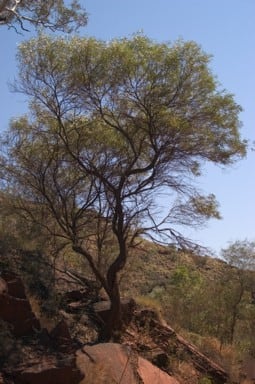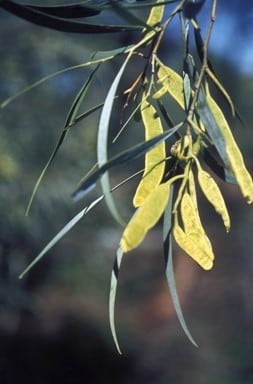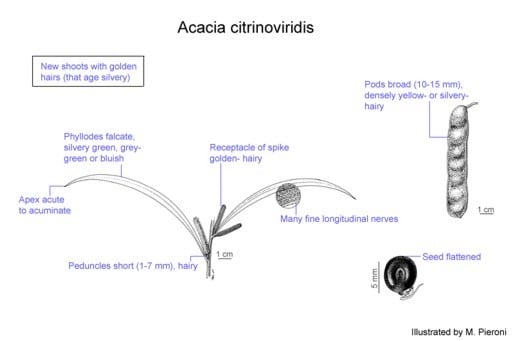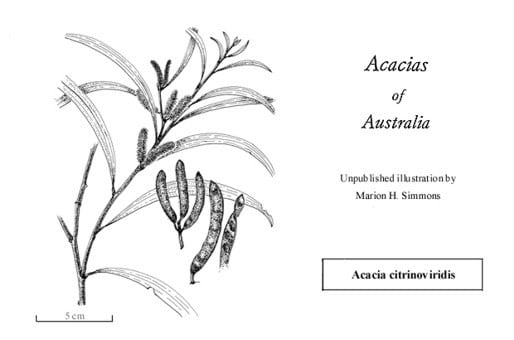Acacia citrinoviridis Tindale & Maslin
WATTLE
Acacias of Australia
Common Name
River Jam, Milhan, Wantan
Family
Fabaceae
Distribution
Occurs in north-western W.A. from near the Gascoyne R. N to the Fortescue R. in the Pilbara.
Description
Graceful tree 5–15 m high, crowns silvery green, greyish green or blue-grey. Bark fissured on stem and branches, grey. Branchlets with pale longitudinal ridges, red-brown, shiny. Young shoots densely clothed with iridescent citron-green hairs (which age silvery white). Phyllodes narrowly elliptic, falcate, acute to acuminate, (5–) 6–12 (–17) cm long, (4–) 7–13 (–20) mm wide, coriaceous, densely sericeous aging glabrous; finely multistriate (7–10 nerves per mm), the central nerve (and a nerve either side of it) subprominent; marginal nerve discrete, narrow, yellowish and not resinous; gland obscure, normally basal. Inflorescences simple; spikes 0.8–3.2 cm long, dense, bright yellow; peduncles 1–7 mm long, densely silvery appressed hairy (hairs rarely patent or pale yellow); receptacle normally with dense, pale yellow to golden (occasionally silvery white), spreading hairs, indumentum sparser (rarely absent) in fruit. Flowers 5-merous; calyx c. 0.9 mm long, dissected ±to base, with lobes linear-spathulate, villous; corolla c. 1.2 mm long, dissected to c. 1/2, densely villous; ovary densely villous. Pods narrowly oblong, straight, 2–12 cm long, 10–15 mm wide, thinly coriaceous-crustaceous, velvety or sericeous with citron-green or silvery white hairs (especially when young). Seeds longitudinal, broadly elliptic to circular (almost globose), dorsiventrally flattened, 5–6.5 mm diam., black or dark brown; pleurogram surrounded by pale halo; areole elliptic, ±closed, cream-coloured to dark green; funicle filiform, cream-coloured.
Phenology
Flowers Feb.–Aug., main flush Apr.–May.
Habitat
Normally found on the banks and floodplains of major river systems and some minor creeks.
Specimens
W.A.: Mount Augustus Stn, J.S.Beard 6089 (NSW); Bedaburra Pool, Mount Gould Stn, R.J.Cranfield 5422 (NSW, PERTH); Tom Price, F.Lullfitz L6167 (CANB, K, NSW, PERTH); Nanutarra Bridge, Ashburton R. Crossing, NW Coastal Hwy, B.R.Maslin 2764 (AD, BRI, NSW, PERTH, US).
Notes
A moderately fast growing species with a long life span (over 40 years), good coppicing ability and a propensity to root sucker. It has horticultural potential for arid and semi-arid areas but is likely to need supplementary watering for successful establishment. Traditional aborigines of the Pilbara ate the seed (uncooked) and gum of A. citrinoviridis, and witchetty grubs found in the roots; the wood was used to fashion various weapons.
Related to A. subcontorta and A. distans (see these species for discussion). It superficially resembles A. hamersleyensis which is distinguished by its straighter, more coriaceous, less hairy phyllodes, broader pods with spreading hairs, and receptacles which are not densely golden hairy. Rare putative hybrids between A. ancistrocarpa and A. citrinoviridis occur between Munjina and Roy Hill Stn in the valley of the Fortescue R. (see A. ancistrocarpa × citrinoviridis), and possibly between A. citrinoviridis and A. tumida var. pilbarensis near Cane River Stn, c. 80 km SW of Onslow (see A. citrinoviridis × tumida var. pilbarensis).
FOA Reference
Data derived from Flora of Australia Volumes 11A (2001), 11B (2001) and 12 (1998), products of ABRS, ©Commonwealth of Australia
Author
Edited by B.R.Maslin
Dr M.D.Tindale and Dr P.G.Kodela with the assistance of M.Bedward, S.J.Davies, C.Herscovitch, D.A.Keith and/or D.A.Morrison
This identification key and fact sheets are available as a mobile application:
URL: https://apps.lucidcentral.org/wattle/
© Copyright 2018. All rights reserved.














